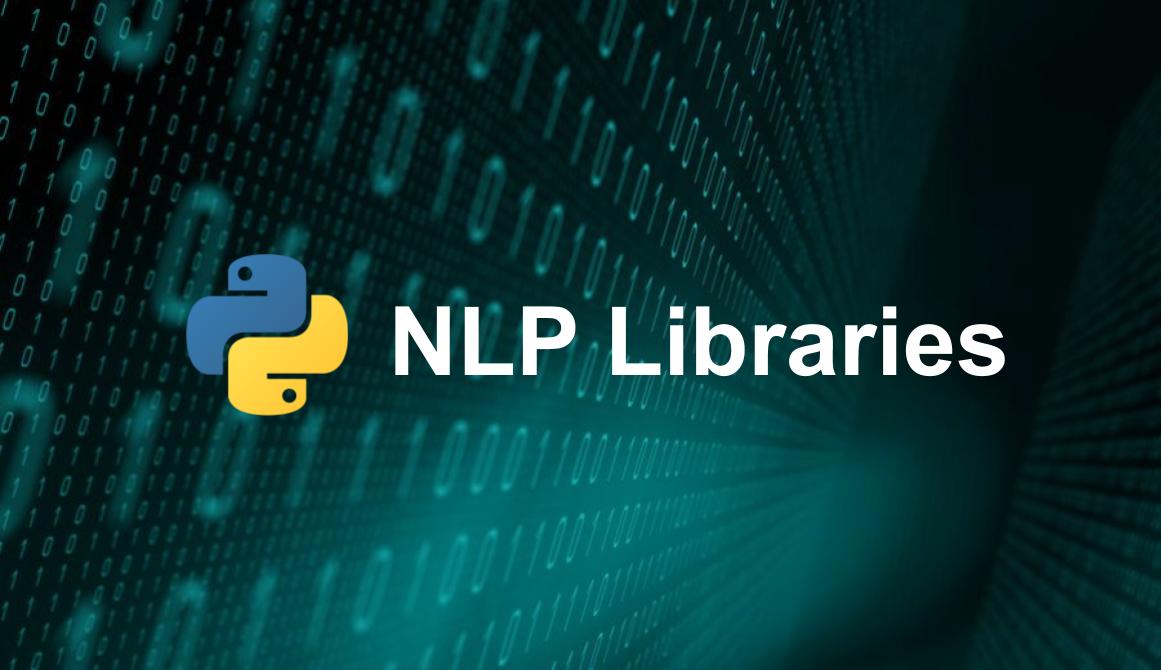Text data the most common form of information on the Internet, whether it be reviews, tweets or web pages. Natural Language Processing (NLP) is a powerful technology that helps you derive immense value from that data. In this article, we will look at the top Python NLP libraries, their features, use cases, pros, and cons.
TextBlob - Great library for getting started
TextBlob is based on NLTK and Pattern. It has great API for all the common NLP operations. It’s a more practical library concentrated on day-to-day usage.
It's great for initial prototyping in almost every NLP project. Unfortunately, it inherits the low performance from NLTK and therefore it's not good for large scale production usage.
TextBlob features
tokenization, POS, NER, classification, sentiment analysis, spellcheck, parsing, translation and language detection
TextBlob use cases
TextBlob Quickstart example NLP use cases:
- Sentiment Analysis
- Spelling Correction
- Translation and Language Detection
Pros
- easy to use and intuitive interface to NLTK library
- provides language translation and detection which is powered by Google Translate
Cons
- slow
- no neural network models
- no integrated word vectors
NLTK - The most famous Python NLP library
We can't talk about NLP in Python without mentioning Natural Language Toolkit (NLTK) is one of the most comprehensive NLP libraries and the most famous Python NLP library.
NLTK is a very powerful tool. It is most popular in education and research. It has led to many breakthroughs in text analysis. It has a lot of pre-trained models and corpora which helps us to analyze things very easily. It is an excellent library when you require a specific combination of algorithms.
The learning curve is steep and most of the time, it’s rather slow and often doesn’t match the demands of real word production usage.
NLTK features
tokenization, POS, NER, classification, sentiment analysis, access to corpora, package for chatbots
NLTK use cases
- Remove stop words and persons names in a Recommendaton System with NLTK
- Sentiment Analysis with NLTK Check if product review is positive or negative.
- Build a chatbot using Python NLTK Understand who is the target audience, the intent or desire of the user and provide responses that can answer the user.
Pros
- most well-know and full NLP library with many 3rd extensions
- supports the largest number of languages compared to other libraries
Cons
- difficult to learn and use
- slow
- only splits text by sentences, without analyzing the semantic structure
- no neural network models
spaCy - Lightning-fast and Gets Things Done!
spaCy is an advanced NLP library available in Python and Cython. It is geared toward performance and operating together with deep learning frameworks such as TensorFlow or PyTorch.
It comes with pre-trained statistical models and word vectors. It features tokenization for 50+ languages, convolutional neural network models for tagging, parsing and named entity recognition.
spaCy features
tokenization, POS, NER, classification, sentiment analysis, dependency parsing, word vectors
spaCy use cases
Search autocomplete (and autocorect) is popular type of NLP that many people use on a daily basis.
Analyze online reviews. Extract the key topics covered by the reviews without having to go through all of them. Help the sellers/retailers get consumer feedback in the form of topics (extracted from the consumer reviews).
Automatic Summarization of Resumes with NER - Evaluate resumes at a glance to facilitate evaluation of resumes at a quick glance, thereby simplifying the effort required in shortlisting candidates among a pile of resumes.
Pros
- fast
- easy to learn and use
- uses neural networks for training models
Cons
- less flexibility compared to NLTK
Gensim - Topic modeling for humans
Gensim is one of the top Python libraries for NLP.
It was originally developed for topic modelling, but today it supports a variety of other NLP tasks, but it is not a complete NLP toolkit like NLTK or spaCy. Its primary use case is working with word vectors.
Word vectors improve our ability to analyse relationships across words, sentences and documents. We’re making an assumption that the meaning of a word can be inferred by the company it keeps. Like the saying, "show me your friends, and I’ll tell who you are".
Gensim features
parallelized implementations of fastText, word2vec and doc2vec algorithms, latent semantic analysis (LSA, LSI, SVD), non-negative matrix factorization (NMF), latent Dirichlet allocation (LDA), tf-idf
Gensim use cases
- converting words and document to vectors
- finding text similarity
- text summarization
Pros
- intuitive interface
- efficient implementation of popular algorithms
- scalable - can run latent semantic analysis and latent Dirichlet allocation on a cluster of computers
Cons
- designed primarily for unsupervised text modeling
- don't implement full NLP pipeline, should be used with other libarary like Spacy or NLTK
Pattern - All-in-One: data mining, scraping, NLP, ML
Pattern library is a multipurpose library capable of handling NLP, data mining, machine learning, network analysis, and visualization. It comes with modules for data mining from search engines, social networks, and Wikipedia. It also can download and parse PDF documents.
It is one of the most useful NLP libraries in Python. While it is not as well-known as spaCy or NLTK, it provides features such as finding superlatives and comparatives, and fact and opinion detection which it stand out from the other NLP libraries.
Pattern features
tokenization, POS, NER, sentiment analysis, parsing
Pattern use cases
Introduction to the Pattern Library NLP use cases include:
- Finding Sentiments
- Spelling Corrections
- Getting Search Engine Results with APIs
- Converting HTML Data to Plain Text
Pros
- data mining web services (Google, Twitter, Wikipedia), web crawler, HTML DOM parser
- network analysis and visualization.
Cons
- not optimized for some specific NLP tasks
Summary - Top Python NLP Libraries
With Python’s extensive NLP libraries Python developers can build amazing text processing applications effectively and help their organizations gain valuable insights from text data.
There are many Python NLP libraries that provide specific features. Choosing the best NLP library for your projects or task is all about knowing which features are available and how they compare to each other.

